Best water flossers 2025: Top 6 oral irrigators from Waterpik, Bitvae and more
The best water flossers to add to your cart this Christmas, as recommended by our expert testers.

If you want to keep your teeth in great condition, the best water flossers can help you step up your dental care routine to the next level. Projecting thing jets of water into your mouth, water flossers can help remove food build-up and plaque, as well as target hard-to-reach places like between teeth, where food particles often remain.
While flossing has its benefits, using a water flosser is time-efficient and offers a more comfortable way to clean between your teeth than 'old-fashioned' flossing. Now is a particularly good time to invest in one—the winter sales are in full swing, offering excellent deals on these grooming tools, and they could even make a good gift. Moreover, improving oral hygiene is a common New Year’s resolution, with flossing often at the top of the list and just as often the first habit to slip.
The best water flossers come with a range of nozzles so you can be sure you'll find one that suits your dental needs. Some even come with tongue scrapers that can help keep your oral hygiene top-notch while reducing bad breath. You can pair a water flosser with one of the best electric toothbrushes for an even better clean, but there's now even a sonic toothbrush with a built-in water flosser (the Soocas Neos II), so even less room for excuses!
Determining the right water flosser for you can be challenging, especially if you've never used one before. To save you time, our expert reviewers have tested some of the best water flossers on the market, from countertop models with generous water reservoirs to cordless options you can use in the shower and take with you when traveling. Here are our top picks.
The quick list

The best water flosser overall
Approved by the American Dental Association, this countertop water flosser offers excellent performance, multiple pressure settings and six separate flossing tips.

Best low-cost water flosser
This stylish cordless water flosser is compact, powerful, easy to refill, and packed with useful features — all without breaking the bank.

Best for braces
Suitable for those with braces, crowns and bridges, the Spotlight water flosser features a tongue scraper, periodontal pocket sprinkler and orthodontic spray tip.

Best to use in a shower
If you like to floss your teeth in a shower, this sleek cordless appliance will impress you with its compact build, performance and ease of use.

Best for traveling
Compact, surprisingly efficient and thoughtfully designed, this colorful water flosser is a perfect travel companion — and it costs only $54.99.

Best water flosser with toothbrush
This flosser-toothbrush combo delivers a top-notch performance and comes with a storage case, travel case, five different water flosser tips, and two brush heads.
The best water flossers we recommend in 2025
Why you can trust Live Science
The best water flosser overall




Specifications
Reasons to buy
Reasons to avoid
✅ You trust the professionals: This flosser is approved by the American Dental Association
✅ You want range: There are no fewer than 10 pressure settings
✅ You want to reach every spot: There are six separate attachments for maximum cleaning
❌ Your bathroom doesn't have power: It needs to be connected to a shave socket or power to work
❌ You want all water contained: It can spray water during operation
🔎 Waterpik Ultra: Recommended by the experts at the American Dental Association, this superior water flosser has multiple settings and attachments for a sparkling clean. It does, however, need a constant power supply. ★★★★½
The Waterpik Ultra Water Flosser features no fewer than 10 pressure settings to help remove up to 99.9% of plaque from the teeth. Perfect for people with braces, crowns, implants, periodontal pockets or bridges, and those who value good oral hygiene, it plugs into a shaver socket to offer continuous charge. The flosser itself is connected to the water reservoir by a lead which springs tidily back into place when you're done flossing.
Waterpik is just one of two water flosser brands approved by the American Dental Association. This means it has been tested and found to be safe and effective at removing plaque and reducing gingivitis.
The Waterpik Ultra Water Flosser offers six separate attachments for flossing, including a Classic Jet Tip and a Toothbrush Tip to allow you to brush as you floss. All these can be stored safely and hygienically in the flip-top lid at the top of the water reservoir.
The manufacturers say the Waterpik Ultra Water Flosser is 15% more powerful than previous models, while the generous water reservoir offers 90 seconds of continuous flossing. It was by far the easiest water flosser we've tested to fill and wipe clean after use, and the 90 seconds of tank capacity makes it easy to floss the whole mouth without needing to refill it.
However, the Waterpik Ultra Water Flosser won't suit every bathroom. It needs to be plugged in to operate, and not all bathrooms have a shaving socket or a shelf close enough to the basin for comfortable flossing. Those who prefer to floss in the shower will need to look for a cordless version instead.
- Read our full Waterpik Ultra Water Flosser review
Best low-cost water flosser
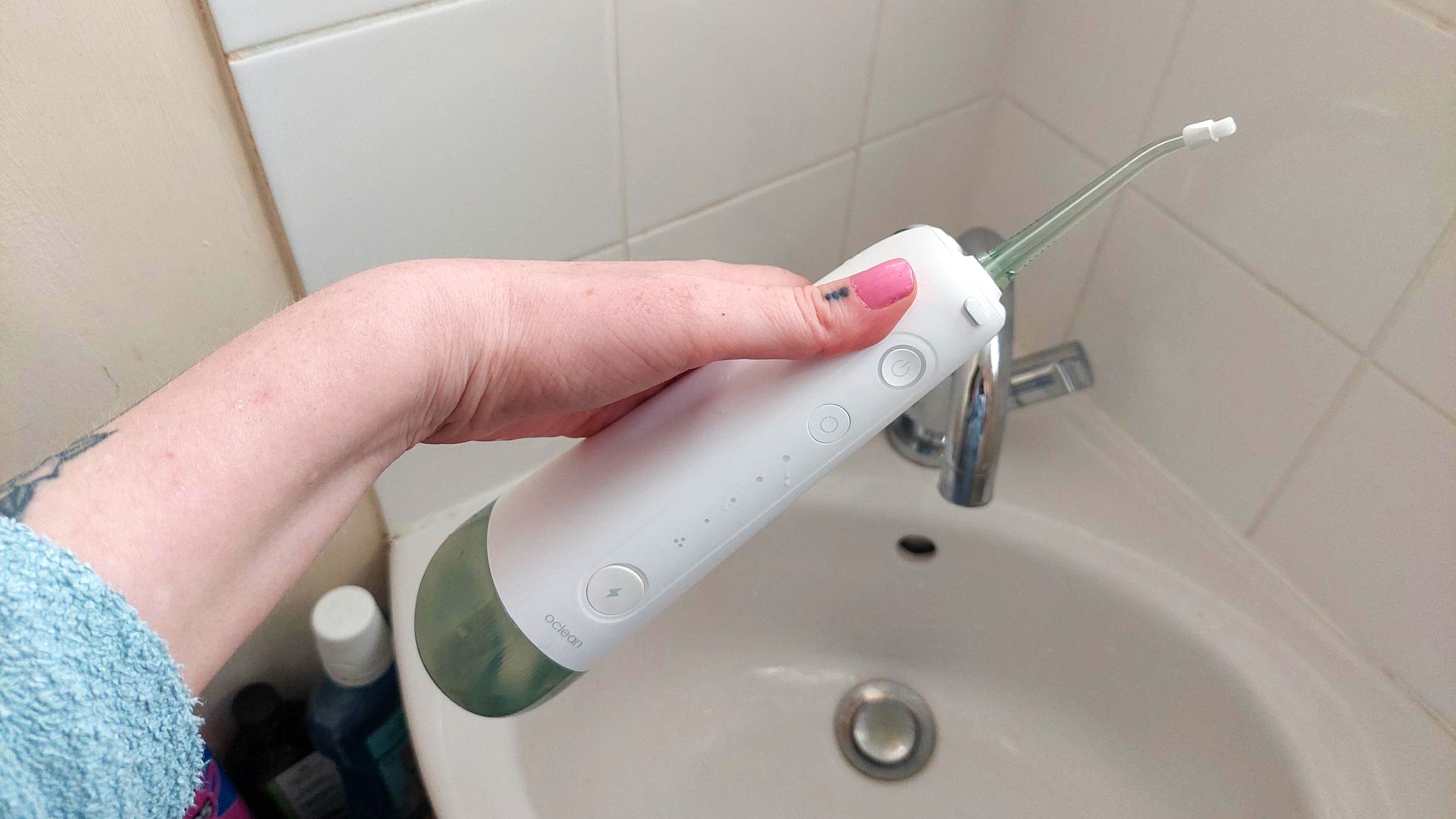
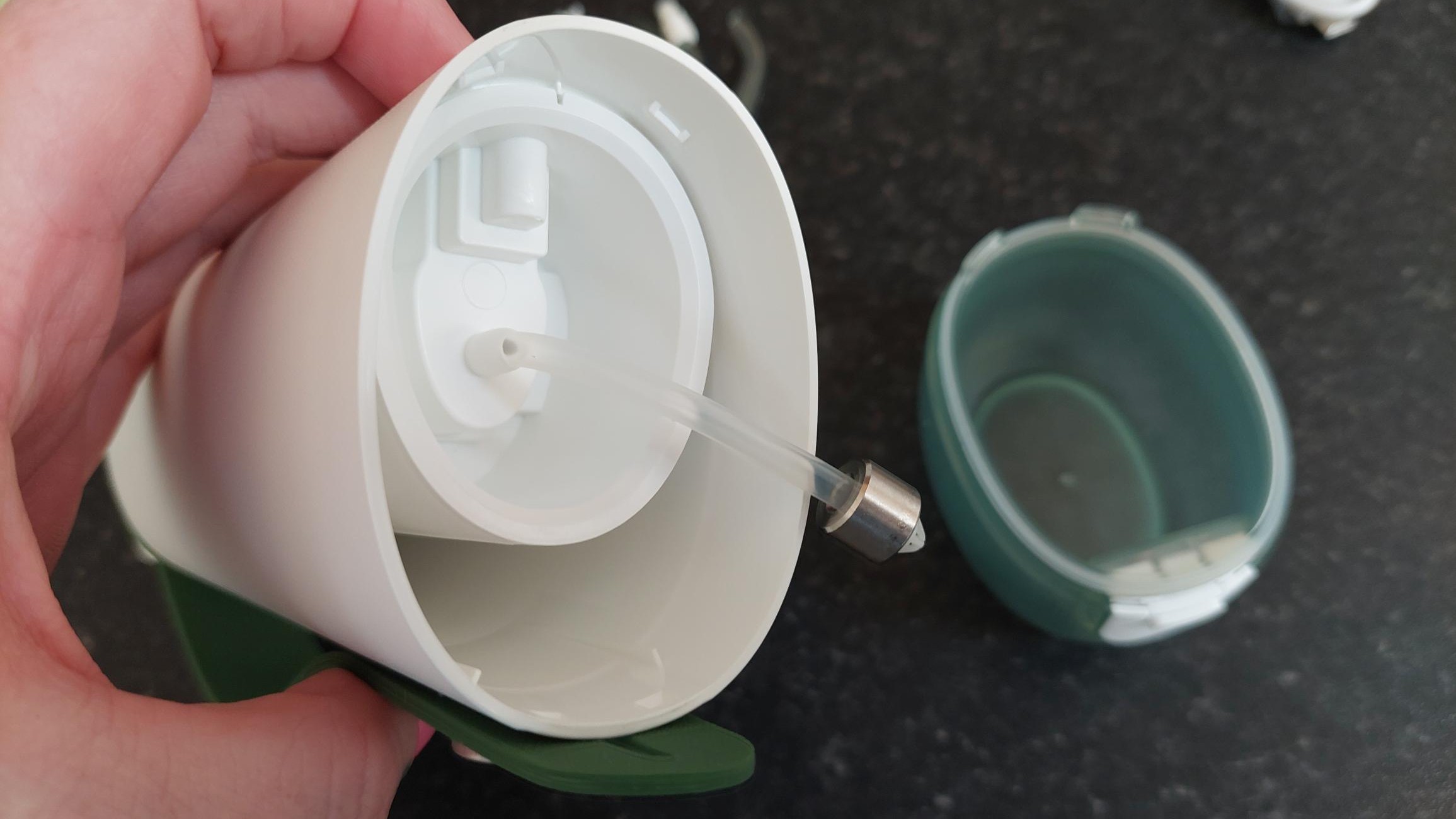


Specifications
Reasons to buy
Reasons to avoid
✅ You want something travel-friendly: The battery lasts up to a month and can be recharged by USB
✅ You like stylish design: The cordless Oclean with its strap for use stands out from its rivals
✅ You like some helpful direction: It features a quad-pacer and a 2 minute timer
❌ You want a big water tank: It runs out pretty quickly
❌ You are sensitive to tastes: There's a plastic taste initially
🔎 Oclean W10: This water flosser stands out with its interesting design, handle for ease of use and helpful timing features. It's great for travel, but the water reservoir is small and may need multiple fillings in one cleaning session. ★★★★½
The unusual design of the cordless Oclean W10 Water Flosser sets it apart from many of its rivals. It includes a thick strap along the length of the unit to allow for a better grip during use. A tactile button is easy to locate while flossing if you want to change the pressure settings too.
The lithium-ion battery lasts up to a month if used once daily and recharges in around four hours using a USB connection, making this a perfect option for traveling.
This water flosser comes with four attachment nozzles, including a standard nozzle, one for periodontal pockets, one for braces and a tongue-scraping nozzle. It also includes five pressure settings ranging from gentle to intensive.
During our at-home testing, we found the water tank ran out fairly quickly during flossing, especially using the intensive mode. However, the tank was easy to refill via the plug located at the top of the flosser. It also includes a quad-pacer to remind you to switch positions and a two-minute timer to ensure you do a thorough job.
- Read our full Oclean W10 Water Flosser review
Best water flosser for braces
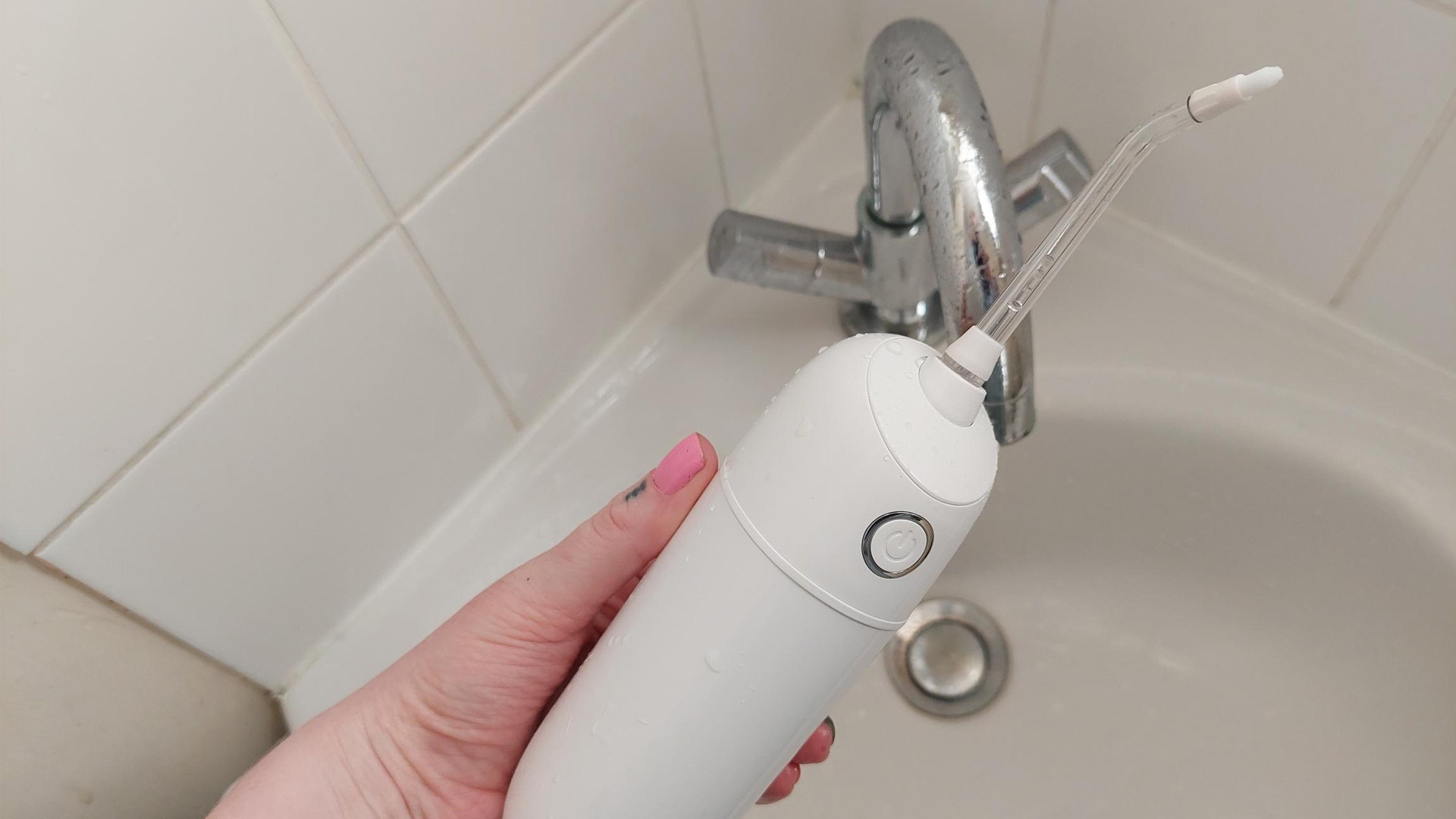



Specifications
Reasons to buy
Reasons to avoid
✅ You or your family have braces: The range of flossing tips are particularly good for braces
✅ You are a frequent traveller: The compact size makes it very portable
✅ You have problem teeth: The periodontal pocket sprinkler is suitable for inflamed gums or impacted teeth
❌ You want something easy to fill: It's tricky to fill the reservoir
❌ You like a long floss: You'll need to refill that reservoir multiple times
🔎 Spotlight Oral Care: This flosser is particularly good for users with braces, featuring an orthodontic spray to get to those tricky areas. But our reviewer did find the reservoir tricky to refill, and it needed refilling often. ★★★★
The high-performing Spotlight Oral Care Water Flosser offers a range of flossing tips designed for different dental needs, making it a particularly good choice for those with braces. This oral irrigator uses a combination of water pressure and pulsations to remove bacteria and plaque from below the gum line and deep between the teeth. It features three pressure settings (normal, soft and pulse) that are adjusted using the single button at the front of the handle.
It comes with a handy USB charger and takes around six hours to reach a full charge, for which you'll get approximately 30 minutes of flossing. It also includes a tongue scraper, a periodontal pocket sprinkler, classic jet tip and orthodontic spray tip. The classic jet tip is excellent for general cleaning, while the orthodontic spray is designed for users with braces. Finally, the periodontal pocket sprinkler is suitable for inflamed gums or impacted teeth.
Unusually the small water reservoir is contained within the body of the handle instead of as a clip-on or screw-on reservoir, which was a little unnerving during our at-home testing. In addition, we found it tricky to fill, and you will need to refill several times if you want to enjoy a thorough floss. Our tester only got a few seconds of use on a high setting before having to refill.
It also took some time to get used to the fact that the reservoir compresses during flossing. However, the compact size of this water flosser makes it ideal for traveling.
- Read our full Spotlight Oral Care Water Flosser review
Best water flosser to use in a shower




Specifications
Reasons to buy
Reasons to avoid
✅ You value ease of use: It's quiet, easy to use and USB rechargeable
✅ You want to share with a partner: It comes with two classics tips
✅ You want to use on the go: You can use in the shower, plus it's travel-friendly
❌ You want all the frills: It has fewer settings and attachments than the countertop Waterpik
❌ You want accessories: There's no travel bag included
🔎 Waterpik Cordless Select: A more portable, cordless version of the classic Waterpik design, this flosser still offers plenty of options in attachments and settings. The reservoir is small, though that is standard for cordless flossers. ★★★½
The Waterpik Cordless Select features a waterproof design, USB magnetic charging and two pressure settings to give you a more affordable and mobile version of the classic countertop Waterpik flosser.
The cordless design is perfect if you're already a Waterpik fan but want something to take into the shower. It features fewer pressure settings and nozzle attachments than the countertop Waterpik, but we think that's more than enough for most flossers. Nozzles include a tip for braces and a plaque-seeker tip, while it also offers two classic tips — ideal if you're sharing your water flosser with a partner. We thought the jet tip was the most useful for getting into hard to reach places on the highest setting.
Two pressure settings (a low of 45 PSI and a high of 75 PSI) offer a gentle clean, or vigorous floss. However, the small water reservoir means you're more than likely to have to refill at least once during your flossing session. That's not unusual for cordless flossers, though.
A ridged wheel at the top of the unit makes it super easy to rotate any nozzle 360 degrees, even with wet hands. We also liked the grippy handle with bumps, so you're less at risk of dropping it if you do have wet hands.
- Read our full Waterpik Cordless Select review
Best water flosser for traveling


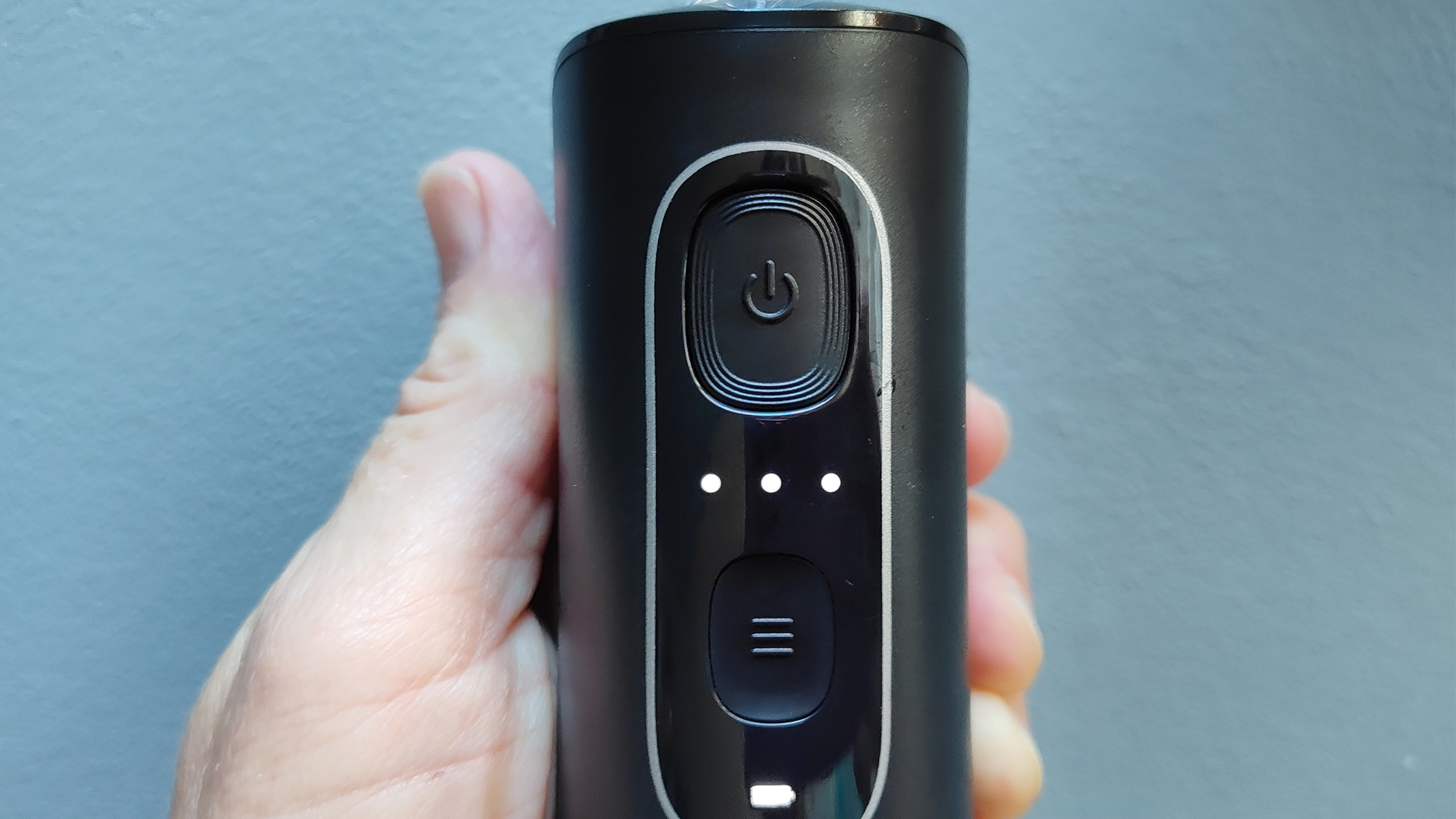

Specifications
Reasons to buy
Reasons to avoid
✅ You want value for money: The Bitvae C2 offers powerful performance for a wallet-friendly price
✅ You like ergonomic design: It's easy to use and easy to refill
✅ You travel a lot: It's cordless design can go 40 days between charges
❌ You want orthodontic tips: There are none included
❌ You want a quiet device: It's relatively noisy
🔎 Bitvae C2: This affordable and well-designed flosser packs a powerful performance into a compact, travel-friendly size - with a large water reservoir as well. It is, though, on the noisy side and there are no orthodontic tips included. ★★★★★
The Bitvae C2 water flosser offers a convenient and affordable way to floss your teeth on the go. This cordless oral irrigator is compact, thoughtfully designed, and can last up to 40 days on a single charge. It also comes with five classic jet nozzles, a tongue scraper nozzle, and a handy USB charging cable.
The C2 model is more ergonomic than traditional water flossers due to its detachable, wide-mouth water tank a large 10oz-capacity (300ml) water reservoir. It is also easy to clean, comfortable to hold, and does not need constant refilling. Moreover, the Bitvae C2 water flosser looks great on the bathroom shelf — it is available in nine colors and does not take up much space.
We were impressed by its performance, too. The Bitvae C2 water flosser gave us a clean and polished feel, and its powerful water jet was slim enough to effectively target hard-to-reach areas around the gum line.
On the other hand, the Bitvae C2 water flosser comes with no orthodontic tips. We also did not enjoy using its tongue scraper. Lastly, this flosser may be relatively noisy.
- Read our full Bitvae C2 Water Flosser review
Best flosser/sonic toothbrush combo




Specifications
Reasons to buy
Reasons to avoid
✅ You're a multitasker: Get two jobs, brushing and flossing in one
✅ You're short on storage space: One unit and one charger is undoubtedly better than two.
✅ You're prone to forgetting to floss: The Soocas Neos II won't let you forget.
❌ You want to be able to brush without flossing: Although you can stop the "deep cleaning" cycle part way through, there is no brush-only mode.
❌ You want app feedback: There are pre-programmed brushing routines, but nothing 'smart' beyond that.
🔎 Soocas Neos II: We loved this toothbrush/flosser combo. We gave away our separate water flosser within days of using this, and our oral health has thanked us for it. ★★★★½
We were very impressed with the Soocas NEOS II. It is a sonic toothbrush and a water flosser in one, an all-in-one oral care tool for people who want to simplify their dental routine.
Released in late 2024, it pairs high-frequency sonic brushing with a built-in 50ml water reservoir that supports flossing immediately after, or at the same time as brushing (depending on which program you choose). It certainly helped us maintain a consistent routine throughout and beyond our hands-on review of the Soocas Neos II.
Design highlights include an IPX8 waterproof rating and a smart-looking handle with an integrated 50 ml water tank. The toothbrush comes in packaging that is made from sugarcane, a thoughtful finish, even if the toothbrush itself isn't made from recyclable materials.
Performance-wise, there are two main cleaning modes: Deep Clean (3 minutes long) and Quick Floss (60 seconds), with Deep Clean available in three intensity levels. We felt a noticeable improvement in cleanliness and gum health within just a couple of days of use. The battery lasts over 30 days per charge, so it's great for travel as well.
Overall, the Soocas NEOS II impressed us. It is a streamlined, effective tool that simplifies daily dental care and encourages users to floss regularly without needing extra devices. We have replaced our existing toothbrush and separate water flosser with this.
- Read our full Soocas Neos II review
Best water flosser with toothbrush
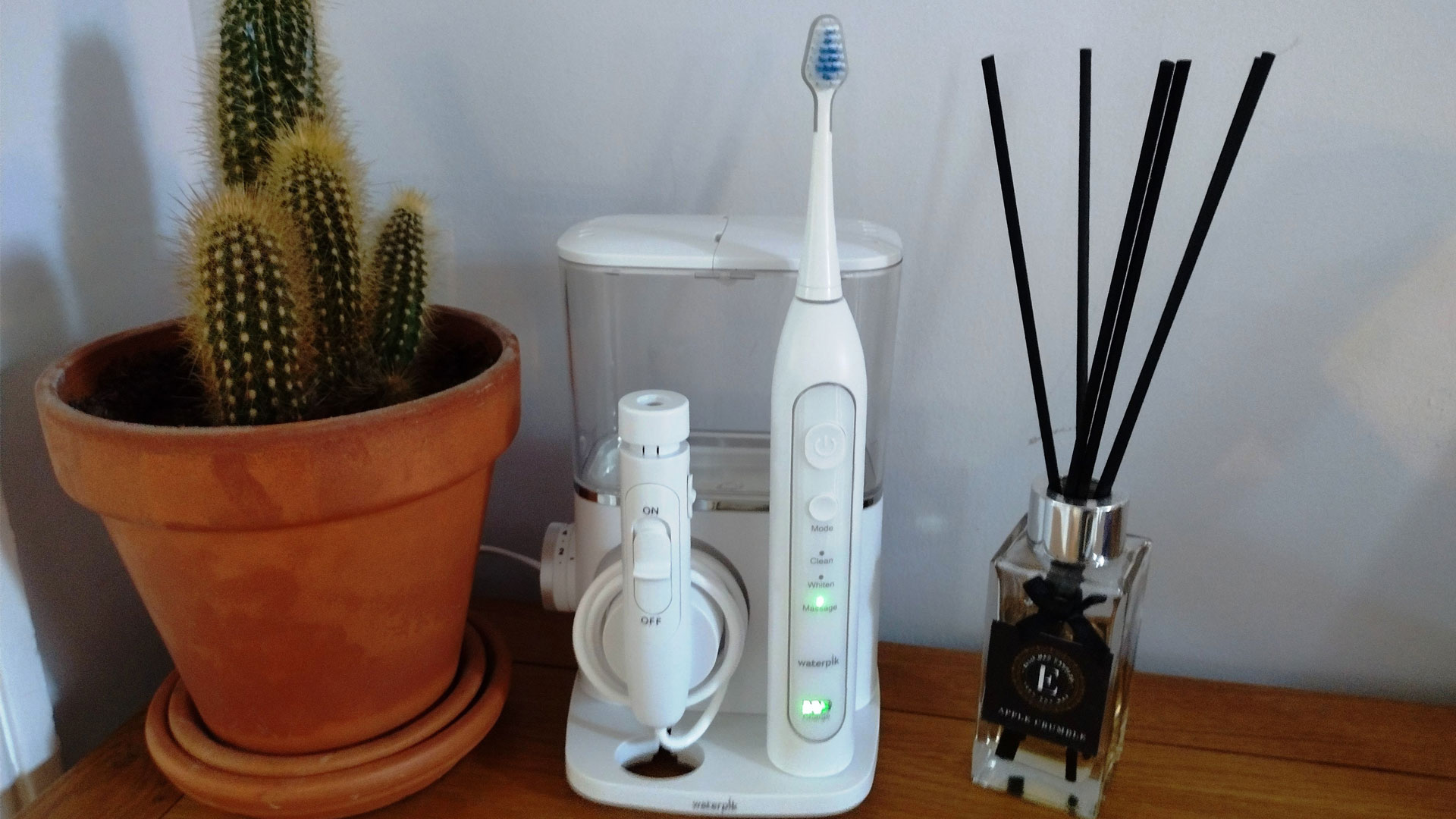


Specifications
Reasons to buy
Reasons to avoid
✅ You want a two-in-one device: It's both a water flosser and an electric toothbrush
✅ You want superior performance: You'll get market-leading technology
✅ You want a deep clean feel: Even the gentle massage mode offers this
❌ Your bathroom doesn't have a socket: It needs to be plugged into work
❌ You want additional features: At this price point we'd expect connected apps or pressure sensors
🔎 Waterpik Complete Care 9.0: This all-in-one flosser and electric toothbrush delivers a powerful performance and beautifully-clean teeth. It's still relatively compact, has a range of attachments and storage and travel cases. However, for the price point, we'd expect more additional features like apps. ★★★★
The Waterpik Complete Care 9.0 combines a water flosser and an electric toothbrush into one cost-effective device. This sleek-looking piece of kit is not small, but it is compact enough to suit those short on shelf space. It also comes with a storage case, a travel case, five different water flosser tips, and two brush heads. More importantly, this toothbrush-flosser combo delivers a market-leading performance.
The Waterpik Complete Care 9.0 offers 3 cleaning modes — General Clean, a more intense Whitening Mode, and a Massage Mode to stimulate the gum area — as well as a tongue-cleaning feature, water pressure control, and a handy 3-minute timer. All three cleaning modes scored high in our at-home tests, but we were most impressed with the Massage Mode. The gentle pulses were easy on our gums, yet powerful enough to give us that ‘deep clean’ feeling.
We liked its battery life, too. This toothbrush-flosser combo can last a week on a single charge, making it a perfect travel accessory. It does not generate much noise, either.
However, there are a couple of drawbacks to the Waterpik Complete Care 9.0. The unit needs to be plugged into a socket close to the wash basin, otherwise it will not work. Also, it does not provide additional features typically seen in devices at this price point, such as connected apps or pressure sensors.
- Read our full Waterpik Complete Care 9.0 review.
Best water flossers: Comparison
Product | Rating | Battery life | Attachment nozzles | Reservoir size |
|---|---|---|---|---|
Waterpik Ultra | ★★★★½ | N/a - countertop plug-in | 6 | 19.98oz |
Oclean W10 | ★★★★½ | Up to 30 days | 4 | 6.4oz |
Spotlight Oral Care | ★★★★ | 30 minutes | 4 | 6.4oz |
Waterpik Cordless Select | ★★★½ | Up to 2 weeks | 5 | 6.4oz |
Bitvae C2 | ★★★★★ | Up to 40 days | 5 | 10oz |
Soocas Neos II | ★★★★½ | Around 30 days | NA | 2 oz |
Waterpik Complete Care 9.0 | ★★★★½ | Up to 1 week | 5 | 22oz |
How we test
How do we test water flossers at Live Science?
During our at-home testing, the Live Science team uses the same protocol to test each water flosser. Our reviewers are experienced in their field so you can rest assured they have done a thorough testing of each of these products. Our testing protocol for water flossers includes using the water flosser on each of its pressure settings, trying out each nozzle to note any differences in performance or intensity and checking battery duration. We also assess the design of each water flosser, noting the colors available, the transparency of the water tanks, how comfortable they are to hold when in use, the settings available and any extra features individual models offer.
When it comes to functionality and performance, we test water flossers for ease of use, how easy it is to clean the reservoir and fill it, the flexibility and rotation of the tips, pressure settings, battery life and charging times, how well the various tips perform and feel when being used and finally, tank capacity. All of this is taken into consideration to award each product a score out of a possible five stars.
Our expert

Dr. Khurrum Hussain, a clinical periodontist at Bupa Dental Care. Dr Hussain is a highly experienced GDC registered Specialist Periodontist, and Implant Surgeon. He completed specialist training at the Eastman Dental Institute (UCL). As a practicing clinical periodontist, he manages both periodontal disease and complex restorative complications. He is now based in the North-west of England, where he is a Clinical Lecturer at the University of Manchester Dental Hospital.
FAQs
Are water flossers effective?
Although independent clinical research into water flossers is still in its infancy, early results show water flossing can be just as effective as regular flossing in removing plaque.
A randomized controlled trial in the Saudi Dental Journal looked at how efficient a water flosser was compared to regular flossing. After just one use of each, they found that water flossers were as efficient as regular floss in removing interdental plaque. As a result, they concluded that water flossing could be recommended for people who struggle with regular flossing, either because of the manual dexterity it requires or because they have dental work, such as braces, bridges or implants.
Similarly, a study in the International Journal of Dentistry compared dental floss with a water flosser in patients undergoing orthodontic treatment. They found that the water flosser was as effective as the dental floss overall, but it was also more effective than the dental floss at removing plaque from the molars.
Not flossing at all carries a higher risk of oral hygiene problems, including gum inflammation and disease. A study in Compendium compared a group of people who only brushed their teeth with another group who brushed their teeth and used a water flosser. The group who added water flossing to their dental hygiene routine had significantly improved gum health after just four weeks.
Given the evidence, water flossers appear to be effective at improving oral hygiene and lowering the risk of gum disease.

Can a water flosser replace flossing?
If you find regular flossing uncomfortable or hard to manage, or if you have dental work that makes it difficult to carry out regular flossing, there's no reason why you can't try a water flosser instead.
In fact, the American Dental Association (ADA) says water flossing can be a great option for people who have trouble flossing by hand, such as people with braces, or permanent or fixed bridges.
However, while approving certain water flosser brands for removing plaque, it's worth noting that the ADA has yet to state that a water flosser is more effective than regular flossing.
If you're not sure whether to opt for a water flosser over your regular dental floss, talk to your dentist or dental hygienist. They may recommend a water flosser if they think you're more likely to use it daily. As we all know, regular flossing, rather than the style of flossing, is more important to good oral hygiene.
Do water flossers work?
Water flossers have gained lots of attention in recent years, prompting numerous studies to look at their effectiveness. Most of these compare water flossers to traditional flossing and interdental brushes.
We’ve taken a deeper dive into research within the last decade and asked an expert to determine if water flossers are more effective than interdental brushes and regular flossing.
The results look promising. A 2021 study in the Saudi Dental Journal compared the effectiveness of a water flosser versus regular floss in removing plaque after a single use. The results demonstrated that the water flosser was equally efficient in eliminating interdental plaque compared to traditional floss. Based on these findings, the researchers concluded that water flossing could benefit people lacking the manual dexterity needed for regular flossing.
There’s more good news for people undergoing orthodontic treatment. Water flossers can make a big difference for people with braces, bridges, or implants by tackling those challenging areas that are tough to clean with traditional floss or interdental brushes.
Live Science spoke to Dr. Khurrum Hussain, a clinical periodontist at Bupa Dental Care, to find out more. “I recommend using water flossers alongside an effective tooth-brushing technique focusing on toothbrushes and interdental brushes,” Dr. Hussain told us.
“They’re particularly beneficial for patients undergoing orthodontic therapy who may have difficulty using interdental brushes or dental floss.”
A 2022 study in the International Journal of Dentistry took a closer look at this. Researchers asked participants to floss one side of their mouth with regular dental floss and the other with a water flosser. Surprisingly, they discovered no significant difference in oral hygiene between the two methods. This finding further confirms that water flossers could be ideal for individuals with dental work. So, if you're undergoing orthodontic treatment, a water flosser could be a game-changer for maintaining your oral health.
Overall, research backs up the effectiveness of water flossers and their benefits for specific dental situations. So, if you're looking for a convenient and efficient way to keep your gums healthy and plaque-free, a water flosser could be just what you need. However, if you’re happy with your traditional floss, it’s reassuring to know you’re not missing out on better oral health either!
How to use a water flosser
Use a water flosser once a day before brushing. This way, you can loosen and remove any plaque and food particles between your teeth and gums, then brush them away with your toothbrush and toothpaste. Using a water flosser before brushing can also help your toothpaste reach deeper into the spaces between your teeth, making it much more effective. Dr. Hussain agrees that timing is essential. “Use the water flosser before brushing your teeth with toothpaste. It removes debris from the spaces between the teeth, enabling better fluoride absorption from the toothpaste onto the enamel.”
Maintaining good oral hygiene is a breeze with a water flosser. Here's a step-by-step guide to help you get the most out of yours:
- Fill it up: Begin by filling the reservoir of your water flosser with lukewarm water. If you want an extra boost, some models allow you to add mouthwash or antibacterial solutions.
- Choose the right tip: Select the flosser tip that suits your needs. Different options, such as standard, orthodontic, or periodontal tips, are available. Check the user manual to find the one that's best for you.
- Adjust the pressure: Most water flossers let you adjust the pressure settings. If you're new to using one, start with a lower pressure and gradually increase it as you become more comfortable.
- Sink-side setup: Lean over the sink to prevent any water from splashing around. It helps keep things tidy while you floss.
- Back to front: Place the flosser tip in your mouth. Dr. Hussain suggests closing your mouth around the nozzle to reduce splashing. Start with your back teeth and work your way forward. Guide the tip along your gum line.
- Angle it right: Aim the flosser at a 90-degree angle to your gum line, and move it along your teeth in a gentle sweeping motion. You should pause briefly between each tooth to allow the water to flush out debris. Dr. Hussain recommends keeping a few millimeters between the water flosser and your teeth, as the sensation can be intense.
- Slow and steady: Slowly move the flosser tip along your gum line, covering your teeth’s front and back surfaces. Take your time to clean each area thoroughly.
- Reach every nook and cranny: Remember to clean all areas, including your teeth's inner and outer surfaces. Pay special attention to those tricky spots like molars and spaces between teeth.
- Rinse time: After flossing, remove the flosser tip and empty any remaining water from the reservoir. Rinse the reservoir and the tip thoroughly to keep them clean and hygienic for your next use.
Many water flossers offer different pressure settings. You can opt for a gentle or soft setting if you have sensitive teeth and gums. You can select a regular or higher setting for a stronger water pulse. Adjust the pressure based on your comfort level and needs.
You can get nozzles designed for cleaning around braces, bridges, or implants.
Remember, it might take a little practice to get the hang of using a water flosser effectively. You might get a lot of splashback when you first start using one.
Check your water flosser manual or ask your dentist for guidance if you have any specific questions or concerns. Happy flossing!
Get the world’s most fascinating discoveries delivered straight to your inbox.
Joanne Lewsley is a UK-based freelance writer and editor, covering health and lifestyle news and features. She mainly creates evidence-based health and parenting content and has worked with a number of global sites, including BabyCentre UK, Medical News Today, Fit & Well, Top Ten Reviews, and Yahoo!
- Anna GoraHealth Writer
- Kate Carter



